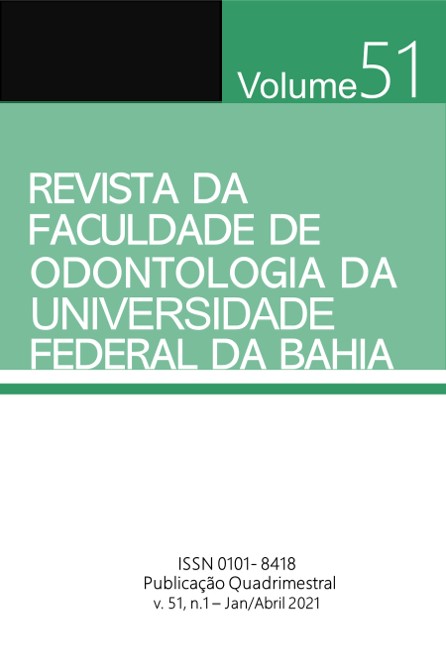CALCIFICAÇÕES DE TECIDO MOLE NO TRAJETO EXTRACRANIAL DA ARTÉRIA CARÓTIDA EM EXAMES DE TC MULTIDETECTORES SOFT TISSUE CALCIFICATIONS IN THE EXTRACRANIAL COURSE OF THE CAROTID ARTERY ON MULTISLICE CT EXAMINATION
DOI:
https://doi.org/10.9771/revfo.v51i1.44214Palavras-chave:
Tomografia Computadorizada por raios X, Artéria carótida externa, Diagnóstico por imagem, Tomography, X-Ray Computed, Carotid Artery, External, Diagnostic ImagingResumo
Introdução: A calcificação de placas ateromatosas na artéria carótida são de grande impacto para a saúde geral dos indivíduos e podem ser diagnosticadas precocemente em exames de imagem de rotina por cirurgiões dentistas. Objetivo: Avaliar a prevalência de calcificações de tecido mole no percurso extracranial da artéria carótida em exames de Tomografia Computadorizada multidetectores (TC). Materiais e métodos: A amostra foi composta por 160 exames de TC multidetectores de maxila e mandíbula. O avaliador, percorreu os cortes axiais de 0.3mm de espessura, de ambos os lados do pescoço e analisou a presença ou não de calcificações na artéria carótida destes pacientes. Os dados foram anotados em ficha específica e analisados de forma descritiva. Resultados: Do total de exames avaliados, 23% foram do sexo masculino e 62% do sexo feminino. Foram encontradas calcificações em 15% dos pacientes, com idade média de 50,8 anos. Conclusão: O presente estudo mostra a alta prevalência de calcificações na artéria carótida nos pacientes avaliados. Uma vez que possíveis calcificações ateromatosas podem exigir encaminhamento para um profissional de referência, monitoramento e até mesmo intervenção. Deste modo, a identificação correta de calcificações presentes na artéria carótida podem levar a um diagnóstico precoce e evitar um acidente vascular encefálico. Portanto faz-se necessário que cirurgiões dentistas e especialistas em radiologia examinem o volume total dos exames de TCs.
Introduction: Calcification of atheromatous plaques in the carotid artery is of great impact to the general health of individuals and can be diagnosed early in routine imaging exams by dental surgeons. Objective: To evaluate the prevalence of soft tissue calcifications in the extracranial path of the carotid artery in multidetector computed tomography (CT) exams. Materials and methods: The sample consisted of 160 maxillary and mandibular multidetector CT exams. The evaluator went through axial slices 0.3 mm thick, on both sides of the neck and analyzed the presence or absence of calcifications in the carotid artery of these patients, the data were recorded in a specific form and analyzed in a descriptive manner. Results: Of the total number of tests evaluated, 23% were male and 62% female. Calcifications were found in 15% of patients, with an average age of 50.8 years. Conclusion: The present study shows the high prevalence of calcifications in the carotid artery in the evaluated patients. Since possible atheromatous calcifications may require referral to a reference professional, monitoring and even intervention. Thus, the correct identification of calcifications present in the carotid artery can lead to an early diagnosis and prevent a stroke. Therefore, it is necessary for dental surgeons and radiology specialists to examine the total volume of CT exams.
Downloads
Downloads
Publicado
Como Citar
Edição
Seção
Licença
Copyright (c) 2021 Revista da Faculdade de Odontologia da UFBA

Este trabalho está licenciado sob uma licença Creative Commons Attribution-NonCommercial 4.0 International License.

